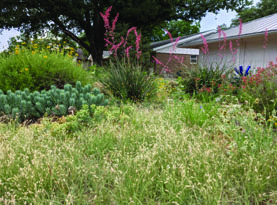By Debbie Roland and
Emmy Ulmschneider
Master Gardeners
Most homeowners lost plants during our winter freeze. Master Gardeners are getting questions about what to plant to replace boxwood, Indian Hawthorne and other hedge type plants that didn’t survive. This is a great time to embrace some change in your yard. Look on the bright side and give adapted, native or non-native plants a try, which will use considerably less water and give pollinators a place to thrive. Let’s dig deeper into these plants which can survive heat, cold or anything West Texas weather can throw at us.
>> Yaupon Holly: Yaupon holly (Ilex vomitoria) is a slow growing, attractive, evergreen shrub which can be pruned into a small tree. The small greenish white flowers, if pollinated, ripen into red berries in the fall. Interestingly, it is our only native source of caffeine and indigenous peoples made tea from the leaves.
Plant Yaupon in full sun or part shade and it thrives in our soil and does not miss a beat in the cold. It can grow from 10 to 30 feet with a 12 foot spread. There are dwarf varieties available which give a beautiful mounding effect. Yaupon holly transplants well and once established does well in drought conditions. Water two to three times a week during the first year, then weekly thereafter.
>> Red Yucca: Red Yucca (Hesperaloe parvifolia) is not actually a yucca, but comes from the Century-plant, Agavaceae family and is a Texas endemic. This evergreen grows up to 3 feet tall and wide with a spike that can add another 3 feet. Flowering in spring through summer pink stems bear colored blooms. As long as it blooms, you will attract hummingbirds and other pollinators.
This plant thrives in full sun but can take part shade. It is a tough plant that can survive droughts and, more importantly, freezes.
These plants will probably be small when you bring them home, but don’t be deceived. They need at least 2 feet on each side to spread out so you can enjoy the contrast of arching sword-like leaves and coral, yellow, red or white flowers. Deer will eat the flowers but avoid the plant.
>> Rosemary: This member of the mint family, Rosemary, (Rosmarinus officinalis) needs 6 to 8 hours of sun and good drainage to thrive. It has woody stems with needle-like leaves that can reach 5 feet in our zone and can be grown as an evergreen hedge. A native to the Mediterranean areas of southern Europe and Asia, it has been introduced here and is perfectly at home. Although a zone 8 to 10 plant, rosemary is perfect in a west facing, reflected sun area; an area where it is often hard to find strong performers.
There are so many uses of aromatic rosemary that every garden should have a plant. Use it for sachets, to flavor roasted nuts, or in stews and soups.
For more information, call the AgriLife office at 498-4071 in Odessa or at 686-4700 in Midland or visit aggie-horticulture.tamu.edu or westtexasgardening.org.




